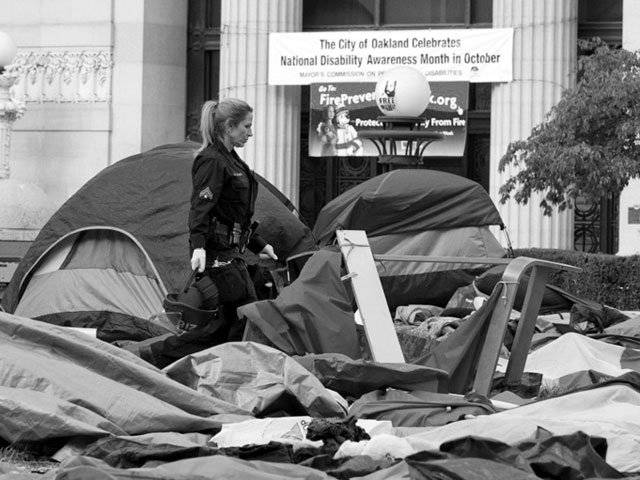SAN FRANCISCO (Reuters) - Oscar Wesley McKinney doesn't carry a placard, and he doesn't chant slogans. He's not even sure he agrees with the message of the Occupy Wall Street movement. But a month ago he left a ballpark where he had been sleeping outdoors and moved into a protest camp in San Francisco's Financial District for one simple reason: "I know my stuff is going to be here when I get home from work." Such practical considerations of safer shelter, food and other amenities have drawn hundreds of homeless people to the anti-Wall Street (AWS) encampments around the country. The presence of the homeless in the camps has highlighted the very economic disparities in American society that the Occupy movement is protesting against. But with them has come the squalor, drug abuse and mental illness often associated with life on the street. Political leaders in some major cities have cited those same issues as reasons for evicting the camps, usually after first trying to lure protesters away with incentives that have included assurances of providing shelter for the homeless. Police swept away a large camp in Los Angeles this week, arresting hundreds of protesters as the city joined the ranks of other municipalities that lost tolerance for camps aligned with the 2-month-old Occupy movement. Philadelphia protesters vacated a similar site under threat of a raid. Even liberal San Francisco, home to one of the largest remaining Occupy settlements, is trying to persuade campers to trade the downtown Justin Herman Plaza site for one 2-1/2 miles (4 km) away, pointing to substance abuse and sanitation problems. No one has counted how many of the roughly 300 people who eat at the San Francisco camp every night are homeless, but it is clear that it has become a beacon for the down and out. In Los Angeles, the homeless accounted for around a third of the roughly 800 people who camped outside City Hall, and homeless contingents were also noted in New York and Philadelphia. "We're happy to accept responsibility for San Francisco's illegitimate children," said Chance Martin, a homeless advocate who volunteers at the camp. Organizers say the problems of the homeless plagued the city long before the Occupy movement came along, and that the camps have simply forced the mainstream public to confront an uncomfortable issue long overlooked or hidden from sight. Ryan Landis, who arrived this week in the San Francisco camp, said Justin Herman Plaza was simply his most recent stop in a downward path that began when the recession destroyed his landscaping business. Struggling with drug addiction, Landis lost his house and went through a divorce. After a drug treatment clinic in the northern California town of Redding turned him away, Landis stumbled across a small Occupy camp setting up in that town. Activists there referred him to San Francisco, 200 miles away (320 km). "San Francisco has more opportunities for growth," he said, as he pulled a black rolling suitcase into the Occupy camp, a stone's throw from posh restaurants and the Federal Reserve building. "This city is famous." Occupy protesters have largely welcomed the homeless in their makeshift communities, touting them as a legitimate part of the 99 percent and sharing food and medical assistance. Those factors helped attract Gary Boatwright from skid row in Los Angeles -- a 50-block area believed to harbour the highest concentration of homeless in the nation -- to the now dismantled Occupy camp in that city in early October. "The 24-hour Porta Potties is a big one," Boatwright said. "Toilet paper is another big one, and you don't have to take your tent down." The camps have also offered homeless people a reprieve from city ordinances aimed at rousting them from public spaces, including one passed this year in San Francisco that bans sitting and lying on sidewalks during the daytime. Maria Foscarinis, executive director of the National Law Center on Homelessness and Poverty, said it could be harder legally and politically for cities to use such laws against Occupy campers because "they are making a public statement." About half of US cities prohibit loitering or camping in public places, according to a survey by the center released in November, and that number is rising. As cities have sought to remove the Occupy camps from often prime downtown locations, they have often focused their efforts on incentives that could also appeal to the homeless. Los Angeles and other cities, including Philadelphia and Oakland, offered shelter beds to homeless campers before shutting down their settlements. David Snow, a University of California at Irvine sociologist who studies homelessness, said it was only natural to find a connection between Occupy protests and homelessness given the protesters' focus on economic inequality issues. "The rise of homelessness in the 1980s could be seen as the canary in the coal mine signalling a rise in inequality that started in the 1970s, continued in the 1980s, accelerated in the 1990s, and is now reaching a crescendo," he said. Counting the homeless has always been difficult. But the US Department of Housing and Urban Development tallied 643,067 people nationwide living without permanent shelter on a single night last January, about the same number it has documented each year since 2007.
Thursday, April 18, 2024
AWS camps lure US homeless

24th ITCN Asia from today
April 18, 2024
Gold rate up by Rs2,200 per tola
April 18, 2024
Rupee sheds 10 paisas against dollar
April 18, 2024
Stock market loses 150 more points
April 18, 2024
Nine held over selling bread on high prices
April 18, 2024
Rail Revival
April 17, 2024
Addressing Climate Change
April 17, 2024
Saudi Investment
April 17, 2024
Political Reconciliation
April 16, 2024
Pricing Pressures
April 16, 2024
Justice denied
April 18, 2024
AI dilemmas unveiled
April 18, 2024
Tax tangle
April 18, 2024
Workforce inequality
April 17, 2024
New partnerships
April 17, 2024
ePaper - Nawaiwaqt
Advertisement
Nawaiwaqt Group | Copyright © 2024





